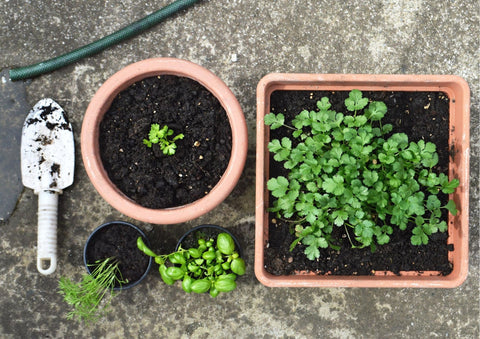Herbs are the perfect way to make food taste better. Fresh herbs will brighten up just about any dish and add flavour. Herbs sold at the grocery store are often in bunches bigger than you need so to save you from removing old rotting herbs that got lost in the depths of your refrigerator, let's have a look at how to grow your own herbs. Taking the time to plant a herb garden can be very enjoyable and easier than you think.
There are a few things to consider when starting a herb garden. How much space do you have? Will it be an inside or outside herb garden?Will you start from seeds or an existing plant?
Here are 6 easy steps to get your herb garden started.

Step 1 Decide On The Location
You will need an area that gets about 6-8 hours of sunlight on a sunny day. Some herbs like parsley, mint, and coriander typically require less, about 3 to 4 hours of sunlight. If going for an inside herb garden then you will need some pots with good drainage, and if not already built in then a tray underneath to catch any excess water. If outside you can choose to keep them in pots (with good drainage), in raised garden beds (gentler growing conditions) or plant them in your regular soil (potting mix for inside plants for better drainage). You will also need the herbs plant or seeds, the right soil (potting mix for inside plants for better drainage), and a small trowel.
A kitchen window sill is a popular place to set up an inside herb garden. This makes it super convenient to acquire you herbs as you cook. You also get the health benefits of looking at your plant!

Step 2 Select The Right Herbs
If you are after starter herbs then rosemary, oregano, thyme and mint are good first options as these plants aren’t too fussy. Chives, basil, parsley and coriander are also good beginner herbs. Also take into consideration how much you like to eat that particular herb. There is no point planting coriander if you think it tastes like soap and take part in the I hate coriander/cilantro day every February 24th.
If going for an outside herb garden and want to help the bees out then basil, chives, chamomile, coriander, fennel, lavender, lemon balm, marjoram, mint, rosemary, sage and thyme are good choices.
Seed packets and plant tags will have some information on them to let you know the conditions the plant prefers (sun and soil) and how much space it needs to grow. It will also give you an idea of how long it will take before the plant is ready to be harvested.

Step 3 Choosing To Grow From Seed Or Ready Grown Plants
Seeds are going to take a lot more patience and planning. Quite often your seeds will be started indoors and then hardened off before being transferred to the garden outside. You are also going to need to check the season to make sure it is suitable for your herb to start growing in as not all herbs do well in the cold. If you are after an instant garden with herbs you can harvest now, then plants are the option for you. You can easily source herbs from garden centers and hardware stores. Supermarkets and fruit markets also offer a small selection of potted herbs.

Step 4 Planting The Herbs
If you’re going to be taking the herb out of the container it came in this is one method to re pot a plan. Fill the new pot no more than half full of potting soil to start with. You can then slightly bring up the potting soil up the side of the new pot and gently press the soil to help it stay in place. Moisten the plant in its original pot to help it slide out of its original pot more easily. Place the herb in the new pot making sure the roots have enough room to move. Fill around the herb with new soil just under the rim of the pot and pat the soil down but not too tightly. Water again to help the roots settle in their new home.
To plant into the ground, dig a hole twice as big as the original pot (width and depth). Then fill half back up with potting soil. Moisten the plant in its original pot to help it slide out of its original pot more easily. Place the plant in the new dug hole making sure the roots have enough room to move. Fill around the herb with new soil in line with the ground, and gently pat down to compress slightly. Water again to help the roots settle in their new home.
If you are growing herbs from seeds, it is best to follow the directions on the packet, as each herbs will have different instructions for sowing. It's also going to take a while before the seedlings are ready for re potting.

Step 5 Set Up A Watering Routine
There is a careful balance when it comes to watering herbs. You don’t want to overwater your herbs, but the soil should also not be dry. You are looking to have something in between.
Not enough water and your indoor herb pots soil will dry out and hurt the plant, too much water and your plant can end up with root rot or fungal infection.
Most indoor herb pots require watering every two to three days, or when the top inch of soil feels dry. Outdoor pots may require watering as often as once a day, or even up to twice a day during extremely warm weather. Watering is best done in the morning so the plants have enough water if the day becomes particularly hot. Direct the water spray at the soil and not the leaves (this can promote mildew and disease). Checking the soil conditions daily ensures the soil contains the correct amount of moisture. A rough guide is to make sure that the herb garden gets 2 inches of water every week.

Step 6 Harvesting You Herbs
You want to harvest your herbs frequently. Frequent harvesting will help the herb plant produce more foliage. In turn increasing the amount you are able to harvest.
To harvest your herb without killing the plant simply cut your herbs with sharp, clean scissors or clippers. This prevents plant damage. If you are pinching with your fingers, clean your hands before starting. Pinch the leaves between your fingers and pull away from the plant.
You can then give your herbs a quick wash before adding to your cooking.



